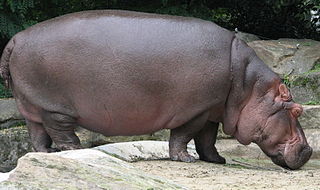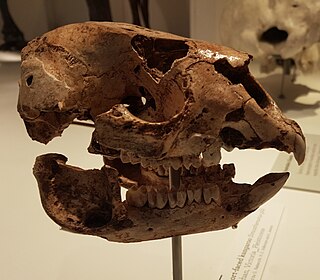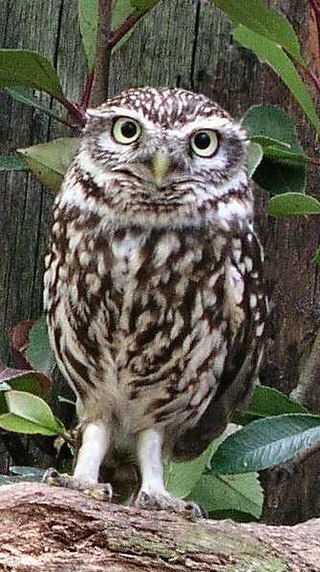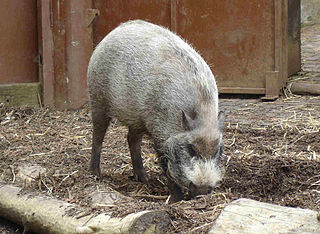
The burrowing owl, also called the shoco, is a small, long-legged, primarily terrestrial—though not flightless—species of owl native to the open landscapes of North and South America. They are typically found in grasslands, rangelands, agricultural areas, deserts, or any other open, dry area with low vegetation. They nest and roost in burrows, and, despite their common name, do not often construct these dwellings themselves, rather repurposing disused burrows or tunnels previously excavated and inhabited by other species, such as American badgers, foxes, ground squirrels or prairie dogs, among others.

Crocodylus is a genus of true crocodiles in the family Crocodylidae.

Hippopotamus is a genus of artiodactyl mammals consisting of one extant species, Hippopotamus amphibius, the river hippopotamus, and several extinct species from both recent and prehistoric times. It belongs to the family Hippopotamidae, which also includes the pygmy hippopotamus and a number of extinct genera.

Procoptodon is an extinct genus of giant short-faced (sthenurine) kangaroos that lived in Australia during the Pleistocene Epoch. P. goliah, the largest known kangaroo species that ever existed, stood at about 2 m (6.6 ft). They weighed about 200–240 kg (440–530 lb). Other members of the genus were smaller, however; Procoptodon gilli was the smallest of all of the sthenurine kangaroos, standing approximately 1 m tall.

The Late Pleistocene is an unofficial age in the international geologic timescale in chronostratigraphy, also known as the Upper Pleistocene from a stratigraphic perspective. It is intended to be the fourth division of the Pleistocene Epoch within the ongoing Quaternary Period. It is currently defined as the time between c. 129,000 and c. 11,700 years ago. The late Pleistocene equates to the proposed Tarantian Age of the geologic time scale, preceded by the officially ratified Chibanian. The beginning of the Late Pleistocene is the transition between the end of the Penultimate Glacial Period and the beginning of the Last Interglacial around 130,000 years ago. The Late Pleistocene ends with the termination of the Younger Dryas, some 11,700 years ago when the Holocene Epoch began.

Athene is a genus of owls, containing nine living species, depending on classification. These birds are small, with brown and white speckles, yellow eyes, and white eyebrows. This genus is found on all continents except for Australia, Antarctica, and Sub-Saharan Africa. An evolutionary radiation of 4 species is also present in the Solomon Islands.

Diplomesodon is a genus of shrew that contains a single extant species, the piebald shrew (Diplomesodon pulchellus).

The Balkan snow vole, also known as Martino's snow vole, is the only living member of the genus Dinaromys. The genus name means "Dinaric mouse", referring to the Dinaric Alps, as the species is endemic to the western Balkans of southeast Europe. Eight subspecies of this vole have been recognized, although in 2022 this number was reduced to two subspecies. The Balkan snow vole is a living fossil, the only living species in the tribe Pliomyini, and might arguably better be placed in Pliomys, a genus established for its fossil relatives even before the Balkan snow vole was scientifically described. It was described by husband and wife mammalogists Vladimir Emmanuilovich Martino and Evgeniya Veniaminovna Martino. Others have argued that Pliomys should be treated as entirely separate from Dinaromys, with Dinaromys and P. lenki estimated to have genetically diverged around 4 million years ago based on ancient DNA sequences. The earliest representatives of Dinaromys like Dinaromys allegranzii date to the Early Pleistocene, with Dinaromys also inhabiting the Italian Peninsula until the end of the Late Pleistocene, when it contracted to its current distribution.

Suinae is a subfamily of artiodactyl mammals that includes several of the extant members of Suidae and their closest relatives – the domestic pig and related species, such as babirusas. Several extinct species within the Suidae are classified in subfamilies other than Suinae. However, the classification of the extinct members of the Suoidea – the larger group that includes the Suidae, the peccary family (Tayassuidae), and related extinct species – is controversial, and different classifications vary in the number of subfamilies within Suidae and their contents. Some classifications, such as the one proposed by paleontologist Jan van der Made in 2010, even exclude from Suinae some extant taxa of Suidae, placing these excluded taxa in other subfamilies.

Lynx issiodorensis, sometimes called the Issoire lynx, is an extinct species of lynx that inhabited Europe during the late Pliocene to Pleistocene epochs, and may have originated in Africa during the late Pliocene. It is named after the town of Issoire where the first remains were found. It probably became extinct during the end of the last glacial period.

The Cretan owl is an extinct species of owl from the Pleistocene of the island of Crete, in the eastern Mediterranean. It was first named by P.D.M. Weesie in a paper in 1982. In life, it would have been at least 60 cm tall, considerably larger than the 22 cm long little owl and appears to have been terrestrially adapted, with relatively short wings and long legs. Its primary prey was likely the endemic mouse species Mus minotaurus, as evidenced by the numerous owl pellets containing it recovered from the caves from which the bones of A. cretensis were found.

Paracolobus is an extinct genus of primate closely related to the living colobus monkeys. It lived in eastern Africa in the Pliocene and Early Pleistocene. Fossils have been found in Kenya and Ethiopia, in places such as the Omo valley.
Warendja is an extinct genus of wombat. It is known from two species, W. encorensis from the Late Miocene Riversleigh site in Queensland, and W. wakefieldi known from the Pleistocene of South Australia, New South Wales, and Victoria. The two species are primarily distinguished by features of their enamel. It became extinct as part of the Quaternary extinction event. Warendja wakefieldi is estimated to have weighed about 10 kg, considerably smaller than living wombats. Warendja thought to be relatively basal amongst wombats, being the most primitive member to possess hypselodont cheek teeth. The morphology of the humerus of W. wakefieldi suggests that it engaged in scratch-digging.

Megalochelys is an extinct genus of tortoises that lived from the Miocene to Pleistocene. They are noted for their giant size, the largest known for any tortoise, with a maximum carapace length of over 2 m (6.5 ft) in M. atlas. The genus ranged from western India and Pakistan to as far east as Sulawesi and Timor in Indonesia, though the island specimens likely represent distinct species.

Cercopithecoides is an extinct genus of colobine monkey from Africa which lived during the latest Miocene to the Pleistocene period. There are several recognized species, with the smallest close in size to some of the larger extant colobines, and males of the largest species weighed over 50 kilograms (110 lb).

Neolicaphrium is an extinct genus of ungulate mammal belonging to the extinct order Litopterna. This animal lived from the Late Pliocene (Chapadmalalan) to the Late Pleistocene (Lujanian) in southern South America, being the last survivor of the family Proterotheriidae.

The Crete Mediterranean forests is a terrestrial ecoregion that encompasses the Greek island of Crete.
Rhinocolobus is an extinct genus of monkey closely related to modern colobus monkeys. It lived in eastern Africa during the Plio-Pleistocene, existing as recently as 1.5 million years ago.
Mus minotaurus is an extinct species of mouse native to Crete during the Late Pleistocene-Holocene. It descended from a Mus musculus -like ancestor that arrived on Crete during the late Middle Pleistocene, replacing Kritimys, a large rat-like rodent that inhabited Crete during the Early and Middle Pleistocene. Both Kritimys and the ancestor of Mus minotaurus, Mus bateae are found together in Stavrós Cave. The Mus batae-minotaurus lineage shows a tendency to increase in size with time, an example of island gigantism, with Mus minotaurus being one of the largest known members of the genus Mus, with a body mass of approximately 54 grams, over 3 times the size of its mainland ancestor. It was likely heavily predated upon by the extinct endemic Cretan owl, as evidenced by the abundance of its remains found in owl pellets. It inhabited the island alongside a species of elephant, the radiation of endemic Candiacervus deer, the Cretan otter, and the Cretan shrew. Mus minotaurus became extinct sometime during the Holocene epoch, with its remains apparently being found in Neolithic and early Bronze Age sites on the island. Its extinction may have been due to competition with the closely related house mouse introduced to the island by humans during the early Bronze Age.















